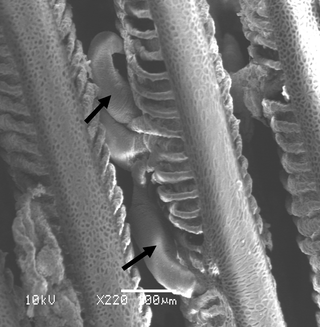Pseudorhabdosynochus auitoe is a diplectanid monogenean parasitic on the gills of the Highfin grouper, Epinephelus maculatus. It was described in 2007.
Pseudorhabdosynochus buitoe is a diplectanid monogenean parasitic on the gills of the Highfin grouper, Epinephelus maculatus. It has been described in 2007.
Pseudorhabdosynochus cuitoe is a diplectanid monogenean parasitic on the gills of the Highfin grouper, Epinephelus maculatus. It has been described in 2007.
Pseudorhabdosynochus duitoe is a diplectanid monogenean parasitic on the gills of the highfin grouper, Epinephelus maculatus. It has been described in 2007.
Pseudorhabdosynochus euitoe is a diplectanid monogenean parasitic on the gills of the Highfin grouper, Epinephelus maculatus. It has been described in 2007.
Pseudorhabdosynochus fuitoe is a diplectanid monogenean parasitic on the gills of the highfin grouper, Epinephelus maculatus. It has been described in 2007.
Pseudorhabdosynochus guitoe is a diplectanid monogenean parasitic on the gills of the Highfin grouper, Epinephelus maculatus. It has been described in 2007.
Pseudorhabdosynochus huitoe is a diplectanid monogenean parasitic on the gills of the highfin grouper, Epinephelus maculatus. It was described in 2007.
Pseudorhabdosynochus cyathus is a diplectanid monogenean parasitic on the gills of the grouper Epinephelus howlandi. It has been described in 2006.
Pseudorhabdosynochus justinei is a species of diplectanid monogenean that is parasitic on the gills of the longfin grouper Epinephelus quoyanus. It was described in 2007 by Binjian Zeng and Tingbao Yang from material from the South China Sea, and redescribed in 2009 by Justine, Dupoux & Cribb from material from off Queensland, Australia.
Pseudorhabdosynochus chauveti is a species of diplectanid monogenean that is parasitic on the gills of the blue grouper Epinephelus cyanopodus. It was described in 2008.
Pseudorhabdosynochus cyanopodus is a species of diplectanid monogenean that is parasitic on the gills of the blue grouper Epinephelus cyanopodus. It was described in 2008.
Pseudorhabdosynochus podocyanus is a species of diplectanid monogenean that is parasitic on the gills of the blue grouper Epinephelus cyanopodus. It was described in 2008.
Pseudorhabdosynochus crassus is a species of diplectanid monogenean that is parasitic on the gills of the camouflage grouper Epinephelus polyphekadion. It was described in 2011.
Pseudorhabdosynochus chinensis is a species of diplectanid monogenean parasitic on the gills of the greasy grouper, Epinephelus tauvina. It was described in 2001.
Pseudorhabdosynochus cupatus is a species of diplectanid monogenean parasitic on the gills of groupers.

Pseudorhabdosynochus lantauensis is a diplectanid monogenean parasitic on the gills of the longtooth grouper, Epinephelus bruneus. It was described in 1981 as Cycloplectanum lantauensis and later transferred to the genus Pseudorhabdosynochus by Kritsky & Beverley-Burton in 1986.
Pseudorhabdosynochus shenzhenensis is a species of diplectanid monogenean parasitic on the gills of the grouper Epinephelus coioides. It was described in 2005.
Pseudorhabdosynochus vagampullum is a species of diplectanid monogenean parasitic on the gills of a grouper. It was described in 1969, from eight specimens, under the name Diplectanum vagampullum and transferred to the genus Pseudorhabdosynochus in 1986. The species has been redescribed several times.
Pseudorhabdosynochus querni is a species of diplectanid monogenean parasitic on the gills of the grouper Epinephelus quernus. It was described in 1968 by Satyu Yamaguti under the name Diplectanum querni and transferred to the genus Pseudorhabdosynochus in 1986. The species has been redescribed in 2005 from the type-material.

